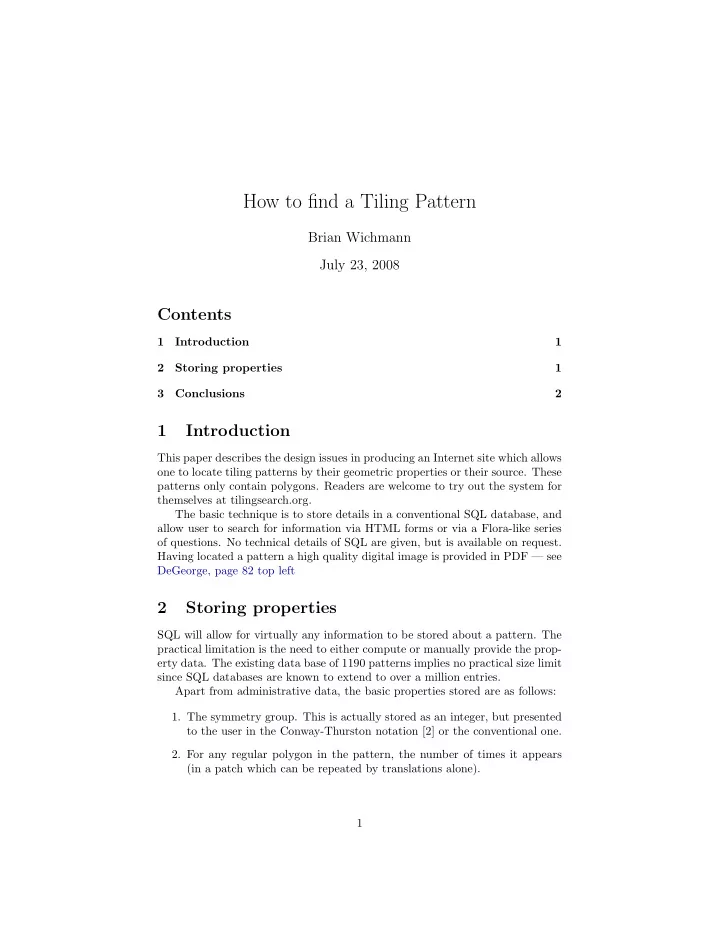

How to find a Tiling Pattern Brian Wichmann July 23, 2008 Contents 1 Introduction 1 2 Storing properties 1 3 Conclusions 2 1 Introduction This paper describes the design issues in producing an Internet site which allows one to locate tiling patterns by their geometric properties or their source. These patterns only contain polygons. Readers are welcome to try out the system for themselves at tilingsearch.org. The basic technique is to store details in a conventional SQL database, and allow user to search for information via HTML forms or via a Flora-like series of questions. No technical details of SQL are given, but is available on request. Having located a pattern a high quality digital image is provided in PDF — see DeGeorge, page 82 top left 2 Storing properties SQL will allow for virtually any information to be stored about a pattern. The practical limitation is the need to either compute or manually provide the prop- erty data. The existing data base of 1190 patterns implies no practical size limit since SQL databases are known to extend to over a million entries. Apart from administrative data, the basic properties stored are as follows: 1. The symmetry group. This is actually stored as an integer, but presented to the user in the Conway-Thurston notation [2] or the conventional one. 2. For any regular polygon in the pattern, the number of times it appears (in a patch which can be repeated by translations alone). 1
3. For regular star-polygons the same as for regular polygons, but the vertex angle in addition. 4. If the internal angles of each polygon in the pattern is a multiple of a value, that value is recorded. 5. A record of whether the pattern can be coloured with only two colours. If the pattern then also satisfies the interlace condition, the number of finite and infinite interlaces [6]. 6. A record of whether the pattern is edge-to-edge. 7. Whether the pattern satisfies the two polygon condition defined in [1]. 8. For the non-regular polygons in the pattern, three numbers are recorded: the number having at least one axis of symmetry, the number of mirror images, and the number without a mirror image. 9. The source data, see Tiling references. Of course, there are many properties that could be recorded, such as those used in [5]. However, very many of these would only provide useful information for very few tilings and hence are not currently used. Given a set of (geometric) properties for a specific pattern, it may be that another tiling shares these same properties. Currently this does not seem to be a difficulty since a final choice can be made visually in locating a pattern. The current emphasis is on classical Islamic patterns for two reasons: they look good and there is a restricted number. In this venture, substantial assis- tance has been provided by Tony Lee [7]. Of the 1190 tilings in the present collection, 497 are thought to be authentic Islamic patterns — so some way to go if the total number is around 3,000. Since the SQL is invisible to users of the system, the properties of patterns are output as HTML text, see DeGeorge, page 82 top left, for the tiling men- tioned above. 3 Conclusions A conventional SQL data base is a convenient means of storing and locating tiling patterns. The current collection does not contain many sequences of mathematical tilings — to increase the collection in this area needs cooperation from those having such sequences so that the the data can be converted into an appropriate format. The current collection lacks substitution tilings [4], not for any inherent reasons but just due to the way the current software works. 2
References [1] J. Dawes and B. A. Wichmann. A New Class of Tilings with Two Prototiles. URL [2] J H Conway, H Burgiel and C Goodman-Strauss. The symmetries of things . A K Peters Ltd. 2008. ISBN 978 1 56881 220 5 [3] B. A. Wichmann, The World of Patterns, CD and booklet. World Scientific. 2001. ISBN 981-02-4619-6 URL (This publication has over 4,000 patterns but it a different format from the on-line system.) [4] Steven Dworkin, Jiunn-I Shieh, Deceptions in Quasicrystal Growth, Commun. Math. Phys. 168, 337 - 352 (1995) [5] B. Gr¨ unbaum and G. C. Shephard, Tilings and Patterns , W. H. Freeman & Co., New York, NY, 1987. [6] B. Gr¨ unbaum and G. C. Shephard, Interlace Patterns in Islamic and Moorish Art. Leonardo , Vol. 25, No. 3/4, pp. 331-339. 1992. [7] A. J. Lee. Islamic star patterns. Muqarnas vol. 4. pp182-197. 1987. Revision record 1. Started, 25th June 2008. 3
Recommend
More recommend